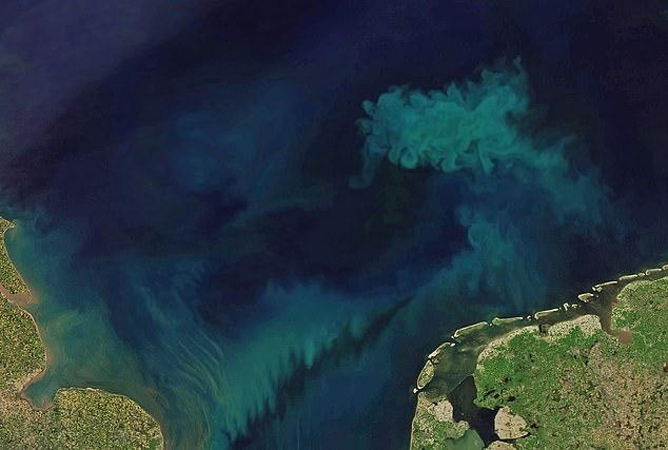Over half of Earth’s oceans have changed colour over the last 20 years


Over half of the world’s oceans have developed a green tinge in the past two decades years, a study shows. Measurements of ocean surface colour taken via satellite over the past 20 years have uncovered a global explosion in the growth of phytoplankton, the plant-like microbes common to the upper ocean.
While many of these microscopic organisms, including green algae, absorb carbon dioxide as they harvest solar energy, their ‘pond scum’-like population boom has contributed to suffocating, oxygen-depleted ‘dead zones’ worldwide.
The colour shift is subtle to the human eye, but NASA-run satellite equipment has confirmed that over 56 percent of the world’s oceans – a vast area larger than Earth’s total landmass – has been turning greener.
‘To actually see it happening for real,’ according to the study’s co-author Stephanie Dutkiewicz, a senior research scientist and climate modeller at the Massachusetts Institute of Technology (MIT), ‘is not surprising, but frightening.’
‘These changes,’ she said, ‘are consistent with man-induced changes to our climate.’ The MIT team, in collaboration with the UK’s National Oceanography Centre, analysed decades of ocean colour data collected by the MRI Spectroradiometer (MODIS) aboard NASA’s Aqua satellite.
The colour data, collected from low Earth orbit, showed that the hotter tropical oceans near the equator have become the most consistently greener over time.
A growth in phytoplankton, the foundation of the marine food chain that helps sustain krill, fish and seabirds and marine mammals, might ordinarily be interpreted as a sign of ocean health.
But the overgrowth and oxygen-sucking decay created by the large masses of theses microbes has been consistently linked to a rise in oceanic dead zones and mass marine migrations for over a decade.
‘I’ve been running simulations that have been telling me for years that these changes in ocean colour are going to happen,’ Dutkiewicz said. ‘So, we hope people take this seriously.’
‘It’s not only models that are predicting these changes will happen,’ she noted. ‘We can now see it happening and the ocean is changing.’
The greening discovered by the researchers’ analysis of NASA’s MODIS-Aqua data from July 2002 to June 2022, published today in the journal Nature, took pains to look out for greening two-times more that the expected signal-to-noise ratio. The result, they said, is that this greening can’t be explained by any naturally occurring, seasonal or year-to-year variations in phytoplankton blooms alone.
‘This gives additional evidence of how human activities are affecting life on Earth over a huge spatial extent,’ according to the study’s lead author BB Cael, of the UK’s National Oceanography Centre in Southampton.
‘It’s another way that humans are affecting the biosphere.’
The researchers tracked seven wavelengths of coloured light from the ocean’s surface via the MODIS system onboard NASA’s Aqua satellite. Although the ocean appears uniformly blue to the naked eye, its true colour contains a mixture of these wavelengths, beyond blue and green to even red, some of which varies much less from year to year and thus provides much more signal than noise.
Cael and his team conducted a statistical analysis using all seven wavelengths measured by the Aqua satellite and not just the two typically used to measure the changes in green chlorophyll pigment from phytoplankton activity.
‘I thought, doesn’t it make sense to look for a trend in all these other colours,’ Dr Cael said, ‘rather than in chlorophyll alone?’
‘It’s worth looking at the whole spectrum, rather than just trying to estimate one number from bits of the spectrum.’
Cael’s group was able to compare these results to a predictive model made by Dutkiewicz at MIT in 2019.
Dutkiewicz’s model simulated the changes on ocean colour based on two scenarios: one with further greenhouse gases added to the atmosphere and another scenario without it.
The greenhouse-gas model predicted that, within 20 years, an approximately 50 percent of the world’s ocean surface would become detectably greener – precisely what Cael found in the real-world MODIS-Aqua data. ‘This suggests that the trends we observe are not a random variation in the Earth system,’ Cael said in a press statement.
‘This is consistent with anthropogenic climate change.’
But, Cael noted that more detailed study than just colour changes would be needed to understand exactly how all of these marine ecosystems across the globe are changing individually due to a hotter planet. ‘The ecosystem is changing-even if it’s hard to say exactly how with the current state of our knowledge about plankton ecosystems,’ Cael told Vice. ‘These colour changes may mean a shift to smaller or bigger plankton, more or less predators or prey, different types of plankton that affect carbon storage or fisheries differently, among other things.’
Recent Posts
- Finance
Finance minister assures EU investors of stronger business support in Pakistan
Finance Minister Muhammad Aurangzeb has assured the government’s support for European Union (EU) businesses in…
- World
Millie Bobby Brown reveals surprising pet collection of 62 animals
Millie Bobby Brown has shared that she now cares for an impressive total of 62…
- Sports
HBL PSL X trophy tour kicks off, bringing cricket fever to 11 cities
The Pakistan Cricket Board (PCB) has launched the first-ever HBL PSL trophy tour, making history…
- Pakistan
Zulfikar Bhutto junior announces political ambitions with PPP Shaheed Bhutto
Zulfikar Ali Bhutto Junior, the son of slain politician Mir Murtaza Bhutto, has announced his…
- Sindh
Sindh govt unveils job portal to help thousands find employment
The Sindh government has launched a job portal to help citizens find employment in…
- Entertainment
Sehar Khan reflects on her transformative role in ‘Tann Mann Neel o Neel’
Sehar Khan's performance as Rabi in the drama "Tann Mann Neel o Neel" has significantly…
Leave a Comment